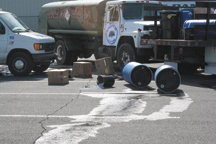A sharp and chilly wind blew off Newark Bay – one of those last gasps of late winter working its way into mid-April. Even with the sun beating down and the stark blue sky, everything seemed cold and remote as the waterside behind Don Ahern Veterans Memorial Stadium looked like a disaster scene.
Fire trucks, emergency vehicles, EMTs, police cars, and men and women in uniforms converged on a portion of the parking lot where a rusting fuel truck slowly leaked water, while in front of it stood a police van, a truck, and a number of overturned barrels supposedly containing cleaning fluids.
“Once it is determined that there has been a possible spill, these teams come into play.” – Greg Rogers
________
To get a full understanding of what takes place, students played out the role of each of the emergency responders and worked side by side with the professionals – Jim Monkowski of the Hudson County Regional Health Commission, as well as officials from the local and county Office of Emergency Management, the Bayonne Police Department, the Bayonne Fire Department, McCabe Ambulance, and the United States Coast Guard – as they would during an actual emergency.
“The parking lot is supposed to be a state highway,” said Frank Travisano of OEM. “For that reason, the state police are here. The Coast Guard is involved because the leak from the oil truck goes into the sewer, which goes into the bay. This means that it has to be contained. There are two private cleanup companies here as well.”
IMTT supplied the oil truck for the exercise.
The object of the drill was to teach Bayonne High School students about handling emergency situations. The exercise also offered students the opportunity to learn about various jobs in public and emergency services.
Started with accident
Chief Greg Rogers said that the Fire Department assigned its hazardous material team and decontamination team to the exercise, but he noted that in an event of an actual emergency, other units would also be involved.
Since the emergency was purported to be the result of a traffic accident, it is likely that police patrol cars would be on the scene first. A fire official would likely arrive at the site to make an evaluation.
“Once it is determined that there has been a possible spill, everything changes, and these teams come into play,” Rogers explained.
Schools Superintendent Dr. Patricia McGeehan and Bayonne High School Principal Richard Baccarrella observed the massive operation from one corner of the parking lot.
“This is an opportunity for them to experience possible career choices,” McGeehan said.
Barraccella said he was grateful to the city and the other emergency management groups for cooperating in this exercise. He said there were about 30 kids involved, covering each area of the emergency situation, including media relations.
Some dealt with victims
The exercise, which took several hours, involved various functions. Some of the students focused on the accident itself, and dealing with the victims.
Rogers noted that a wrapped-up fire hose simulated a victim on the ground, while real people waited for rescue inside a police van.
The most serious victims were brought to decontamination first, then to waiting ambulances for treatment.
Meanwhile, other students got into contamination suits and began to address the leaking fuel, seeking to minimize the release into the waterway. In this pretend situation, some of the contamination leaked into Newark Bay, which required additional equipment and safety precautions for those dealing with the spill.
